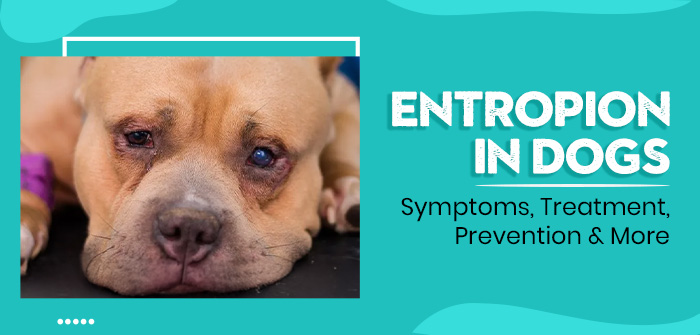Entropion in Dogs: Symptoms, Treatment, Prevention & More
Entropion is an uncomfortable and painful eye problem that affects many dogs. If you notice your dog showing signs of entropion, such as excessive blinking and pawing at their eyes, it is essential to address it, as it may lead to corneal ulcers, perforations, vision interference, and other potentially serious eye problems. Protect your pet’s vision and comfort by learning about what entropion is, why it occurs, and how to treat or prevent it through this blog post.
What is Entropion in Dogs?
Entropion is a condition in which a dog’s eyelid rolls inward, causing the eyelashes and surrounding hair to rub against the cornea. This constant friction can lead to eye irritation, inflammation, pain, ulcers, sores, and even vision loss if left untreated. If entropion is causing excessive pain, it is considered a medical emergency.
Entropion can affect one or both the eyes or one or both the eyelids. It is usually a hereditary, developmental, or anatomic problem commonly affecting young pups, but it can also develop later in life due to injuries, inflammation, or other eye issues.
Common Symptoms of Entropion in Dogs
Recognising the early signs of entropion in dogs is essential for effective treatment. Here are some of the symptoms to look out for:
- Frequent blinking
- Visible inward rolling of the eyelid
- Excessive tearing or watery eyes
- Redness or inflammation around the eyes
- Squinting or keeping one eye partially closed
- Constantly rubbing or pawing at the eyes
- Mucoid discharge from the eyes
- Corneal ulcers or cloudiness
- Pigment growth in the cornea
- Depression or obvious signs of pain
If you notice any of these signs, it’s best to consult your veterinarian for prompt treatment.
What Causes Entropion in Dogs?
Dog eyelid entropion has two main causes:
- Congenital Entropion
Being the most common type of cause, when entropion is congenital, it may be present at birth or usually develops before the pup. This type of entropion usually results from abnormal eyelid shape or loose facial skin. Certain dog breeds like Shar Pei, Chow Chow, Labrador, Bulldog, Saint Bernard, Great Dane, Rottweiler, and Mastiff are predisposed to entropion due to their physiology and genetics.
- Acquired Entropion
Acquired entropion is the term used to describe entropion that develops later in life as a result of diseases such as neurological disorders, persistent eye inflammation, or eye injuries. Sometimes, severe weight loss in dogs may cause sunken eyes, which can occasionally cause the eyelids to fold inwards and cause pain.
How Is Entropion Diagnosed?
A veterinarian can diagnose entropion through various eye examinations. They will examine the shape and position of the eyelids, the level of corneal irritation or damage, signs of ulcers or inflammation, etc.
They may put a numbing drop of proparacaine into the affected dog’s eyelid to unroll the eyelid. If it still doesn’t unroll, they can confirm that the entropion is due to a developmental abnormality. But if it unrolls, it suggests spastic entropion, which generally occurs due to eye conditions like corneal ulcers.
In some cases, the veterinarian may also put a stain (fluorescein dye) on the eye to check for corneal ulcers. If the fluorescein stain glows under a cobalt blue light upon examination, it indicates the presence of an ulcer.
Sometimes, if further investigation is required, a veterinarian may also perform tear production tests to assess eye moisture levels and tonometry tests to check the pressure in the eyes.
Treatment for Eyelid Entropion in Dogs
In puppies and young dogs (congenital entropion), the condition may not cause severe symptoms, and the dog may grow out of entropion without any treatment. However, a quick treatment becomes essential if the dog experiences discomfort as well in case of acquired entropion.
The treatment of entropion depends on the dog’s age, breed, and the severity of the condition. This includes:
- Blepharoplasty (permanent treatment): It is a surgical procedure that involves removing a small section of skin near the affected eyelid to adjust its position and prevent inward rolling. Entropion surgery is performed under general anaesthesia, and dogs may take up to a few weeks to recover fully.
- Eyelid tacking (temporary treatment): Generally recommended for puppies, eyelid tacking is placing temporary sutures to roll the eyes outwards. When this is done, the entropion might resolve on its own, but if the issue persists, surgery may still be required later.
- Entropion management (short-term relief): A veterinarian may recommend lubricating eye drops, antibiotic ointments, and anti-inflammatory treatments to manage the symptoms of entropion in cases where immediate surgical procedures are not essential.
What Can You Do to Prevent Entropion in Dogs?
Unfortunately, congenital entropion cannot be prevented, especially in predisposed breeds. However, you can reduce the risk of complications by:
- Inspecting the eyes regularly
- Avoiding trauma to the eyes
- Monitoring for early signs of discomfort
- Not breeding dogs known to have entropion
If you notice any signs of entropion, such as squinting, discharge, redness, or visible changes in the eye, take your dog to a veterinary hospital without any delays. Timely treatment of entropion is crucial to prevent corneal ulcers, scarring, or vision loss.
Conclusion
Entropion in dogs may sound alarming, but with early diagnosis and proper treatment, your furry friend can return to a life free of eye pain and irritation. Whether your dog needs surgery or temporary relief, working closely with your veterinarian ensures the best outcome.
